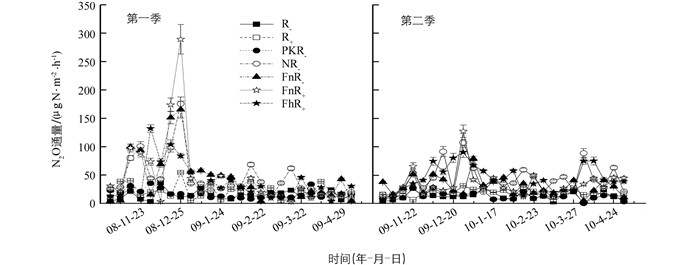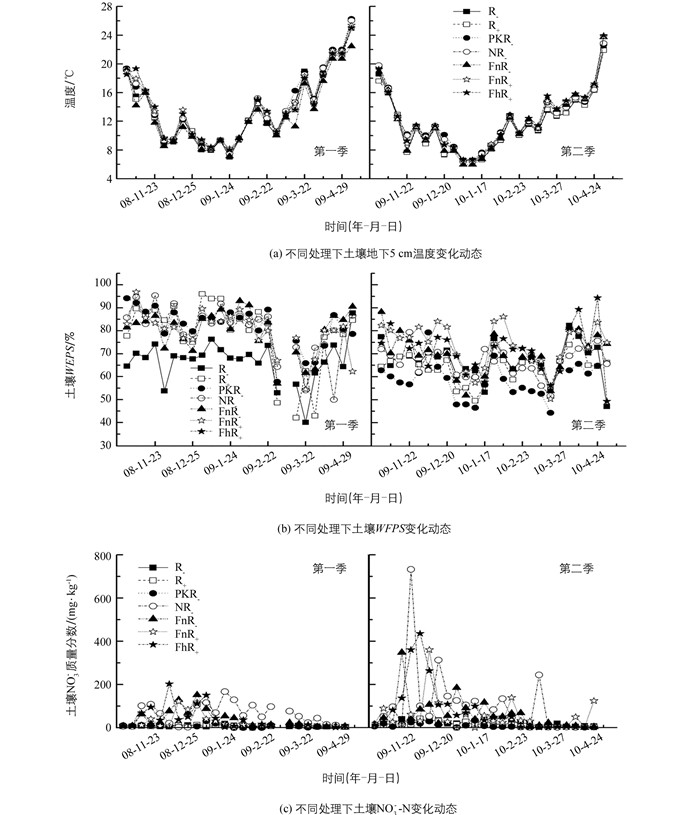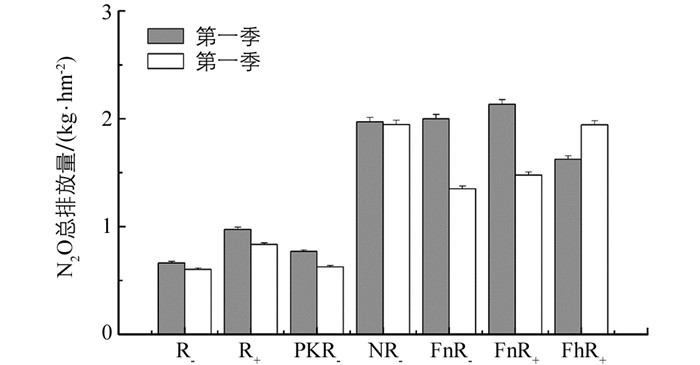-
由于人类活动引起的温室气体大量排放导致了气候变化和全球变暖等一系列重大的全球性环境问题,是当今备受关注的全球变化研究主要课题之一,CO2,N2O和CH4是大气中3种最主要的温室气体,对全球增温的贡献率达到了80%,其中N2O全球增温潜势(GWP)最大,且能破坏臭氧层增强紫外辐射从而危害人类健康[1-2].农业土壤作为N2O最主要的人为排放源,受农业管理措施影响强烈,不同地区及农业生态系统由于N2O排放的时空变异性,排放系数差异较大. IPCC(2006)[3]对确定污染排放的两大关键因子:排放因子及活动水平数据要求越来越严,编制排放清单时尤其要求应尽量使用当地排放系数,因此长期定位监测不同区域较为典型的农业生态系统尤为必要.我国紫色土(主要为耕地)集中分布在川渝盆地地区,面积约为2 198.8万hm2,约占全国的51%[4],对紫色土N2O排放进行连续的田间原位监测对建立该区域乃至中国温室气体排放清单都具有重要意义.目前对于紫色土N2O排放已经有了一定研究,但已有研究主要侧重于不同耕作系统和方式[5-6]、氮肥类型[7-8]等对N2O排放的影响,秸秆还田作为重要的农业生产方式目前被大力推行,但其对N2O排放的影响却鲜有报道,关于不同施肥方式下土壤N2O的排放研究也比较匮乏.本研究在位于重庆北碚18 a长期不同施肥处理的国家紫色土肥力与肥效监测基地内,对不同施肥、秸秆还田方式下紫色土N2O排放进行了连续2a稻麦轮作麦季的原位监测,探讨水分、肥料施用以及秸秆管理等对紫色土N2O排放的影响,并进一步估算与化肥施用和秸秆还田相关的N2O排放系数,以期为紫色土N2O减排措施及川渝地区温室气体排放清单编制提供参考和依据.
全文HTML
-
试验地(106°26′E,30°26′N)位于重庆市北碚区国家紫色土肥力与肥效长期监测基地,海拔266.3 m,属于亚热带季风气候,年平均降水为1 105 mm,降雨主要分布在5月-9月,多年平均气温18.4 ℃,日照1 276.7 h.该区域土壤为侏罗系沙溪庙组紫色泥、页岩发育的灰棕紫泥,是重庆市以及紫色土中分布面积较为广泛的一个土属,具有代表性.
试验地于1991年秋季开始长期肥力与肥效试验,施行水稻-小麦轮作制度,共设12个不同处理小区,小区面积120 m2(10 m×12 m),各小区独立排灌且互不渗漏.本试验选取其中7个处理小区:①不施肥+秸秆不还田(R-);②不施肥+秸秆还田(R+);③施PK肥+秸秆不还田(PKR-);④施N肥+秸秆不还田(NR-);⑤NPK正常施肥量+秸秆不还田(FnR-);⑥NPK正常施肥量+秸秆还田(FnR+);⑦1.5倍NPK施肥量+秸秆还田(FhR+).氮肥用尿素(N),磷肥和钾肥分别用过磷酸钙(P2O5)和硫酸钾(K2O),施肥管理为当季生长季内施用一次基肥和一次追肥,N肥的60%及全部P,K肥做基肥,N肥的40%于3~4叶期做追肥,本试验两个麦季施肥、追肥时间均为当年度的11月1日、12月15日;还田秸秆选用前茬作物水稻秆,其中水分质量分数为20%,养分质量分数折合成N,P(P2O5),K(K2O)分别为0.64%,0.039%和1.78%(干基),方式为将切成约10 cm的稻秆均匀撒在小区土壤表面并翻耕.各处理施肥、秸秆还田量及土壤基本理化性质(试验前即2008年11月份测定)如表 1所示.
-
于2008-2010年的麦季(11月-次年5月),每隔约10 d采样1次,时间控制在上午9:00~11:00.将采样箱(内径20 cm,高25 cm)底端插入植株行间土壤中至3 cm深处(以避免底部漏气)并放置约10 min使箱内外空气达到扩散平衡.罩箱20 min,共采集3个气体样品,按扣箱时间0,10,20 min的间隔用60 mL聚丙烯注射针筒抽取箱内气体,来回抽动3次混匀气体后抽取50 mL保存于Tedlar气体采样袋后迅速带回实验室测定.每个试验小区设置3个平行采样点作为重复,并定期对采样点地表杂草进行清理.每次采样同时在每个试验小区S型多点采集表层(0~10 cm)土样,除去其中的植物根系、残渣和石头后混合均匀放入样品袋中密封标记,带回实验室后于4 ℃冰箱冷藏储存进行测定分析.
-
气体样品N2O排放通量测定采用电子捕获检测器(ECD)(GC-2014,岛津公司).每次采样同时通过数显温度计(JM624,中国)测定采样点附近地下5 cm处土壤温度.土壤重量含水量测定采用铝盒烘干法,取土样于烘箱105 ℃下烘干至恒质量,求前后差值.小麦收割后通过环刀法测定土壤容质量,土壤充水空隙度(WFPS)按照公式WFPS(%)=(土壤质量含水量×土壤容质量)/(1-土壤容质量/2.65) 来计算.土壤NO3--N质量分数采用去离子水浸提(土、水比1:5),25 ℃下振荡30 min后离心10 min(4 000 r/min),将上层清液真空抽滤过0.22 μm醋酸纤维滤膜后用离子色谱仪(DX-120型,戴安公司)进行测定.
土壤N2O瞬时排放通量计算公式为:
式中:F为N2O瞬时排放通量[μgN/(m2·h)];ρ为N2O标准状态下的密度(1.26×10-9 μg/m3);dc/dt为N2O排放速率;V为静态箱有效空间体积(m3);A为静态箱底面积(m2);T为采样时静态箱内空气温度(℃).
土壤N2O累积排放量计算公式为:
式中:Ci+1为第i次和第i+1次采样期间的N2O累积排放量(kg N/hm2);Fi为第i次采样时N2O瞬时排放通量;i为采样次数;D为两次采样间隔天数.
-
数据统计分析采用Excel 2003和SPSS 13.0,用Origin8.0作图.
1.1. 试验地概况与试验设计
1.2. 样品采集与分析
1.2.1. 样品采集
1.2.2. 测定方法
1.2.3. 数据处理
-
如图 1,第一季(2008-2009年麦季),4个施氮处理(NR-,FnR-,FnR+和FhR+)N2O排放幅度在3.15~289.25 μg N/(m2·h)之间,排放峰和排放最大值均主要出现在基肥后的11月中旬和追肥后的12月底,1月中旬后降低到60 μg N/(m2·h)以下,此后除NR-外,均在不超过60 μg N/(m2·h)的范围小幅波动.小麦生长前半期(11月-1月)N2O平均排放通量约为后半期(2月-4月)的2~6倍. 3个未施氮处理(R-,R+和PKR-)N2O排放通量则在3.15~54.24 μg N/(m2·h)范围变化且波动较小,并均明显低于施氮处理(p<0.01).
第二季(2009-2010年麦季),4个施氮处理N2O排放幅度在4.90~127.36 μg N/(m2·h)之间,NR-,FnR+和FhR+处理随时间变化动态规律与第一季相似,表现为在11月-12月出现较大排放并出现最大值,不同的是在4月上中旬仍出现了不同程度增长,而观测期内FnR-处理N2O排放波动幅度较小(均<60 μg N/(m2·h)),未出现明显峰值(图 1).小麦生长前半期各施氮处理N2O平均排放量高于后半期. 3个未施氮处理N2O排放变化趋势与第一季相似,在0.68~28.05 μg N/(m2·h)范围小幅波动且均明显小于施氮处理(p<0.01).由各处理两麦季生长期N2O排放得,除FnR+外各处理N2O平均排放通量第二季均较第一季低.
-
图 2显示的是不同处理下环境因子的变化动态.由图 2a可得,前后两麦季生长期内各不同处理土壤地下5 cm温度分别介于7.00~26.27 ℃,5.97~23.97 ℃,总体均呈现出先下降后上升趋势,小麦生长前半期的平均温度明显低于后半期.不同的是各处理地下5 cm温度第二季均略低于第一季.
-
从图 2b可以看出,前后两麦季生长期内各不同处理处理土壤WFPS分别介于40%~98.75%,44.29%~94.37%.第一季土壤WFPS总体上均较高,除R-处理外各处理除了在2月中下旬到4月初出现单峰近似凹谷型,此外均长期保持在大于70%的范围波动.年际变化上,各处理第二季WFPS均明显低于第一季(p<0.01),低于60%低谷出现3次,分别在1月初、3月底和4月底.
-
第一季,4个施氮处理土壤NO3--N质量分数介于0.01~201.94 mg N/kg,均在施基肥和追肥后出现峰值,此后逐渐降低至30 mg N/kg以下并长期在此范围小幅震荡波动(图 2c).各施氮肥处理土壤NO3--N质量分数平均值介于23.67~59.45 mg N/kg,其中NR-处理最高且明显高于其他施氮处理. 3个未施氮处理土壤NO3--N质量分数则变化平缓,均在低于30 mg N/kg范围小幅波动,平均值介于6.81~9.48 mg N/kg.第二季,各施氮处理NO3--N质量分数介于0.003~732.30 mg N/kg,平均值介于52.2~97.02 mg N/kg,变化趋势与第一季相似,生长季前2个月出现NO3--N质量分数峰值及最大值,但下降速度较缓慢,3月初才降至30 mg N/kg以下.各未施氮处理NO3--N质量分数平均值介于9.62~18.17 mg N/kg,与第一季变化类似.对比两小麦季得各处理NO3--N质量分数第一季均低于第二季,施氮处理NO3--N质量分数均明显高于未施氮处理(p<0.01),小麦生长前半期NO3--N平均值均高于后半期.
-
不同处理N2O平均和累计排放量除FhR+外第二季均低于第一季,土壤地下5 cm温度没有明显年际差异,土壤WFPS第二季则较第一季要高.有研究表明土壤温度、水分是影响土壤N2O的产生和排放的重要因素,可以通过影响微生物活性和土壤生化反应中相关酶的活性等进而影响土壤硝化、反硝化作用过程,土壤水分变化还将影响土壤微生物群落结构[9].推测正是由于第二季土壤WFPS偏低抑制了土壤反硝化反应和N2O产生,是N2O排放量年际差异的主要因素.许多研究都发现N2O排放与土壤水分成正相关[10-11],本试验N2O平均排放通量与土壤WFPS有一定的正相关性,进一步表明土壤水分较高能促进N2O排放(表 2).
表 2中仅第二季R+,PKR-以及FhR+处理地下5 cm温度与N2O排放负相关分析具有统计学意义(p<0.05),且两季不同处理土温与N2O排放相关性分析无统计学意义(p>0.05).马静[10]等研究发现麦季N2O排放与不同深度土温均无显著相关性,其N2O排放变化动态及基肥、追肥时间与本试验相似,推测正是不同施肥掩盖了温度对N2O排放的效应.邹建文[11]等研究发现稻麦轮作下麦季土壤温度升高促进了N2O排放,本研究并未发现两者有明显相关关系,且小麦生长前半期的N2O排放量要高于后半期恰与邹建文的观测结果相反.本试验于11月-12月小麦生长前期施基肥和追肥,此时土壤氮素质量分数较高,而随着植物体吸收、地表径流及渗漏损失等到了小麦生长期后期其质量分数逐渐降低,而土壤矿质氮等反应底物的浓度显著制约土壤硝化、反硝化作用,邹建文的研究于2月底至3月初的小麦生长中后期追肥,这也解释了两研究间排放量高低的时间差异.
由表 2得,第一季FnR+处理以及两麦季FnR-处理土壤NO3--N质量分数与N2O排放通量正相关相关性分析具有统计学意义(p<0.01),且两麦季不同处理土壤NO3--N质量分数与N2O平均排放通量相关性分析均有统计学意义(p<0.05或<0.01),可见不同处理下N2O排放差异主要是由于不同的土壤NO3--N质量分数.反硝化反应是土壤产生N2O的重要过程,而NO3--N是反硝化反应底物并能直接促进反硝化速率,且能够抑制N2O被还原,当土壤中质量分数较低时反硝化速率将受到限制从而抑制N2O生成[12].
-
由图 3得R+处理N2O两季累积排放量分别高出对照R-处理46.7%,38.3%,表明秸秆还田促进了土壤N2O生成与排放;NR-及FnR-处理两季较对照R-处理分别高了103%,133%,105%,62%,平均高出118%,84%,可知施用化肥较秸秆还田对N2O排放促进更明显. N2O两季累积排放量FnR+及FhR+处理较对照R+处理分别高了119%,77%,67%,130%,平均高出98%;FnR+较FnR-处理分别高了6.7%,9.4%,平均高出8.1%;FhR+处理虽第一季较FnR-处理低了19%,但第二季高出44%,综合来看高出13%,表明秸秆与化肥配施对N2O生成与排放具有一定协同促进效应,其原因可能是外源氮添加降低了土壤C/N比并有利于微生物对秸秆的利用.本研究中施氮较未施氮明显促进了土壤N2O生成与排放(p<0.01),推测氮肥正是造成土壤N2O排放差异的主要因素.外源氮添加提高了土壤供氮水平,为微生物硝化、反硝化过程提供了充足的底物,盈余的氮刺激小麦及其根系生长,其根系分泌物也提高了土壤硝化、反硝化微生物活性.而施用秸秆提高了土壤C,N水平,同时刺激土壤硝化、反硝化细菌繁殖与活动并增加反应所需能量和底物[13],本研究中秸秆还田处理明显促进了土壤N2O排放(p<0.01),熊明彪[14]等在同一地点的研究也发现秸秆与氮磷钾肥配施促进了小麦根系的生长发育并加快根系代谢与呼吸速率,进而增加土壤N2O排放.
N2O累积排放量NR-处理较FnR-,FnR+处理第一季相差均不大(p<0.05),但第二季分别高出44%,32%,两季平均高出21%,12%;较FhR+处理第一季高出21%,第二季差异不大,两季平均高出11%,表明农田偏施氮肥较平衡施肥促进了N2O排放,平衡施肥更有利于植物生长并吸收利用更多氮,生成N2O可利用氮相应降低,这与刘运通[15]等的研究结果基本一致.但并非平衡施肥均降低了N2O排放,蔡延江[16]等研究发现施用中量有机肥时NP配施较单施N肥处理促进了N2O排放,黄树辉[17]等研究结果表明施氮量360 kg/hm2时无明显差异而低于270 kg/hm2时NP配施则降低了N2O排放.本研究仅探讨了单施和偏施化肥对N2O排放影响,对于不同化肥类型及施用量下N2O的排放还有待进一步研究.
-
N2O背景排放量是许多地区N2O排放核算最敏感因子之一[18].本研究中不施氮处理(R-和PKR-)N2O两季累积排放量分别为0.66,0.60 kg N/hm2和0.77,0.63 kg N/hm2,两季均值分别为0.72和0.62 kg N/hm2,处理间及年际间显著性分析均无统计学意义(p>0.05),小区长期无氮肥施用(截至试验开始已18 a),N2O排放量年际差异较小,可认为不确定范围较小.关于紫色土N2O排放已开展了一定的研究,但N2O背景排放量结果差异较大.江长胜[5]对小麦-紫色土体系N2O背景排放量3 a观测结果为1.08,4.07和2.46 kg N/hm2,通过对紫色土玉米季的研究,项虹艳等[7]得到的N2O的背景排放量观测值为0.88 kg N/hm2,与本研究观测结果接近,而张中杰[8]等的研究其麦季紫色土N2O背景排放量为0.4 kg N/hm2.稻麦轮作下麦季各地区不同类型土壤N2O背景排放量介于0.13~4.01 kg N/hm2[5, 19-21],本试验观测结果在此范围内.
作物生长期N2O排放通量估算方程为E=E0+EF×N,式中E0为背景排放值,EF为排放系数,N为氮素用量. IPCC[3]推荐使用的化学N肥N2O排放系数为1%,也适用于对有机物如植物残体等作用下的土壤N2O排放估算.以不施氮处理(R-和PKR-)为无氮对照,将其N2O累积排放量两季均值计算施氮处理外源N素N2O排放系数(表 3).两季秸秆N素N2O排放系数分别为0.66%,0.56%,均值为0.61%,化肥N素N2O排放系数介于0.54%~0.98%,均值为0.85%,N2O排放系数均值化肥N素是秸秆N素的1.4倍,说明不同N素来源N2O排放系数具有差异性,估算不同来源N素引起的N2O排放却采取相同的排放系数是不准确的.石生伟等[22]研究发现不同施肥下双季稻化肥N素N2O排放系数高达0.85%,而稻秆+化肥N素N2O排放系数仅为0.24%;邹建文[19]的研究同样表明,稻麦轮作下冬小麦季秸秆N2O排放系数介于0.15%~0.59%,而化肥N素N2O排放系数却高达1.49%.以无氮处理为对照本研究两麦季外源输入N素N2O排放系数分别为0.75%,0.63%,均值为0.69%,较IPCC推荐值(1%)低,若直接选用IPCC推荐排放系数对本研究区域N2O排放进行估算其结果将远远大于该区域实际值.而秸秆N素N2O两季排放系数以FnR-为对照计算分别为0.35%,0.33%,平均为0.34%;化肥N素N2O排放系数以R+为对照计算分别为0.86%,0.48%,平均为0.67%,以无氮处理为对照所得计算结果分别为上述结果的1.8,1.3倍,可知估算农田土壤N2O排放量时针对于不同来源N素选择不同对照计算结果差异较大.
2.1. N2O排放通量的动态变化
2.2. 土壤环境因子的动态变化
2.2.1. 土壤温度
2.2.2. 土壤WFPS
2.2.3. 土壤NO3--N质量分数
2.3. 环境因子对N2O排放影响
2.4. 不同施肥对N2O排放影响
2.5. N2O排放系数估算
-
1) 两麦季施氮处理(NR-,FnR-,FnR+和FhR+)N2O排放波动幅度较大,小麦生长前半期均出现较强N2O排放并明显高于后半期,未施氮处理(R-,R+和PKR-)N2O排放波动较平缓,两麦季变化趋势相似并均明显低于施氮处理.土壤N2O排放第二季较第一季要弱,年际差异较大.
2) 不同施肥是引起N2O排放差异的主要原因.同一小麦生长期内不同处理下N2O排放差异主要是由土壤NO3--N质量分数不同造成的;土壤WFPS第二季明显低于第一季,主要导致了N2O排放情况年际不同.
3) 秸秆还田处理增加了农田土壤N2O排放,单施氮肥与之相比增排效果更明显,秸秆还田与化学氮肥协同作用下同样促进了N2O生成与排放.平衡施肥较单施氮肥处理N2O排放量总体上要少,在实际农业生产中,若考虑农田N2O减排应多选择平衡施肥而减少偏施氮肥.
4) 化肥或秸秆N来源下农田N2O排放系数不同(两麦季下均值分别为0.85%,0.61%),可见在估算N2O排放量时针对不同N素来源农田应选用相对应的N2O排放系数.综合考虑输入的肥料N得本试验区域外源输入N(化肥和秸秆)农田N2O排放系数均值为0.69%,较IPCC推荐值(1%)低,因此估算川渝地区乃至全国农田N2O排放量时应尽量采用适合所在区域的N2O排放系数.




 下载:
下载:

